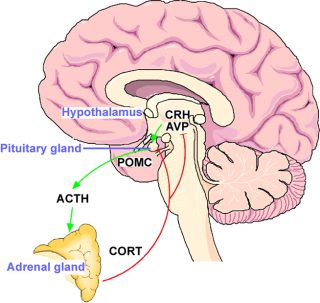We believe in professional growth of Physiotherapists with high technology!
Hypothalamo Pituitary Adrenal Axis-In a nutshell

Just as the name suggests, the HPA axis is an interesting connection of the hypothalamus and the pituitary gland located just above the brainstem and the adrenal glands present on the kidneys.
It is a major neuroendocrine system that functions when the body is in a crisis or a stressful situation. The HPA axis plays a vital role in coordinating the action of the midbrain, the organs with the release of numerous hormones.
Recent research has shown that the HPA axis is the body’s energy regulator and is responsible for modulating the immune system and digestive system due to its ability to release hormones.
Function of HPA axis during stress:
When stress or any stressful situation lasts for a longer period of time, the HPA axis comes into action. The paraventricular nucleus of the hypothalamus causes a release of corticotropin releasing factor (CRH) and arginine vasopressin (AVP) into the apophyseal portal blood connecting the hypothalamus with the pituitary gland. Both these hormones stimulate the anterior pituitary gland to release Adrenocorticotropic Hormone (ACTH) which further prompts the adrenal glands to release cortisol. The Cortisol, which is synthesized from cholesterol, is the main glucocorticoid in the zona fasciculata of the human adrenal cortex, acts as a biomarker for stress. This cortisol causes metabolic changes.

To prevent over activity, the HPA system is modulated through negative-feedback loops designed to maintain predetermined hormone levels and homeostasis. There are two types of receptors for cortisol—mineralocorticoid (type-I) and glucocorticoid (type-II) receptors—both of which participate in the negative-feedback mechanisms. Cortisol binds more strongly for the mineralocorticoid receptors (MRs) than the glucocorticoid receptors (GRs). Because of this difference in binding affinity, the MRs help maintain the relatively low cortisol levels circulating in the blood during the daily (i.e., circadian) rhythm. Only when the cortisol concentration is high (e.g., during a stressful situation) it binds to the GRs with lower affinity which terminates the stress response. This delicate negative feedback control mechanism maintains the secretion of ACTH and cortisol (1)
In Chronic Stress, the HPA axis is over-stimulated thus leading to an inhibition of the negative feedback to the HPA axis causing a burnout.
What is burnout?
The term “burnout” was coined in the 1970s by the American psychologist Herbert Freudenberger. He described the consequences of severe stress and high ideals in “helping” professions. Doctors and nurses, for example, who sacrifice themselves for others, would often end up being “burned out” – exhausted, listless, and unable to cope. (2)
Symptoms of burnout are:
- Emotional exhaustion.
- Alienation from work related activities.
- Reduced performance and creativity.
- Pain and bowel problems.
Role of HPA axis in Circadian Rhythm:
A circadian rhythm is a natural, internal process that regulates the sleep-wake cycle and repeats roughly every 24 hours. (3) The Suprachiasmatic nucleus, a part of the hypothalamus, is the “Body Clock” that maintains the efficiency of the cycle. This rhythm functions due to the action of two hormones ACTH and cortisol. Normally, in non stressful situations, a certain level of cortisol is maintained in our blood. The release is optimal in the morning and lowest during night. In healthy individuals, the cortisol shows a diurnal variation by rising in the 30-60 minutes after awakening, then dipping, followed by another peak in the late afternoon. An abnormality in the release of these hormones can lead to insomnia, chronic fatigue syndrome and seasonal affective disorder.
Immune System:
A number of cytokines like interleukins and tumour necrotic factors (TNF) activate the HPA axis which in turn modulates the immune response. High levels of cortisol suppress inflammatory reactions and trigger immune cells such as monocytes and neutrophils to release anti-inflammatory cytokines. This helps to protect the organism from overactivation of the immune system, and minimizes tissue damage from inflammation.
Role of Quantum Resonance Therapy on HPA axis :
QRT is a combination treatment which includes Pulsed Electromagnetic Field therapy (PEMF) and Magneto Mechanical Oscillator (MMO)
- On Stress :
- Stimulating production of healthy blood cells, both red and white.
- Strengthening the immune system.
- Regulating cortisol, a hormone that can rapidly increase with stress and cause health problems.
- Increasing one’s sense of well-being.
2. On Circadian Rhythm :
It leads to activation of Delta waves and Theta waves that cause REM and NREM sleep patterns.
3. On Immune system:
It has anti-inflammatory effects which helps to trigger immune responses.
To summarize, it produces oscillations that induce relaxation and stress on the body. This induces sleep and also enhances the functioning of the immune system due to the reduction in stressors.
Recent concerns about Hypothalamus :
There is abundant presence of magnetite nanoparticles in the hypothalamus that match precisely the high-temperature magnetite nanospheres, formed by combustion and/or friction-derived heating, which are prolific in urban, airborne particulate matter (PM). Because many of the airborne magnetite pollution particles are <200 nm in diameter, they can enter the brain directly through the olfactory nerve and by crossing the damaged olfactory unit. This discovery is important because nanoscale magnetite can respond to external magnetic fields, and is toxic to the brain, being implicated in production of damaging reactive oxygen species (ROS). Because enhanced ROS production is causally linked to neurodegenerative diseases such as Alzheimer’s disease, exposure to such airborne PM-derived magnetite nanoparticles might need to be examined as a possible hazard to human health. (4)







